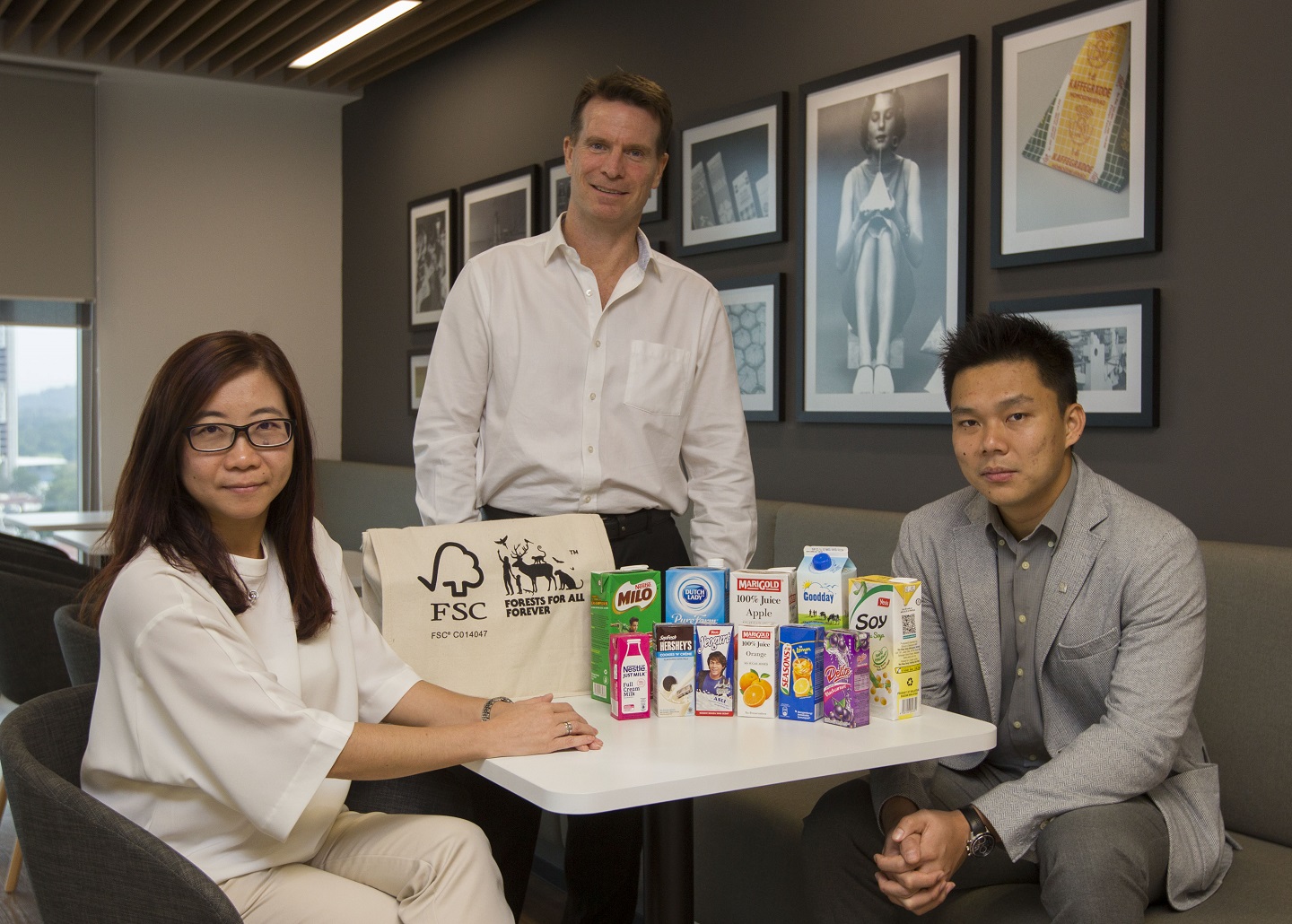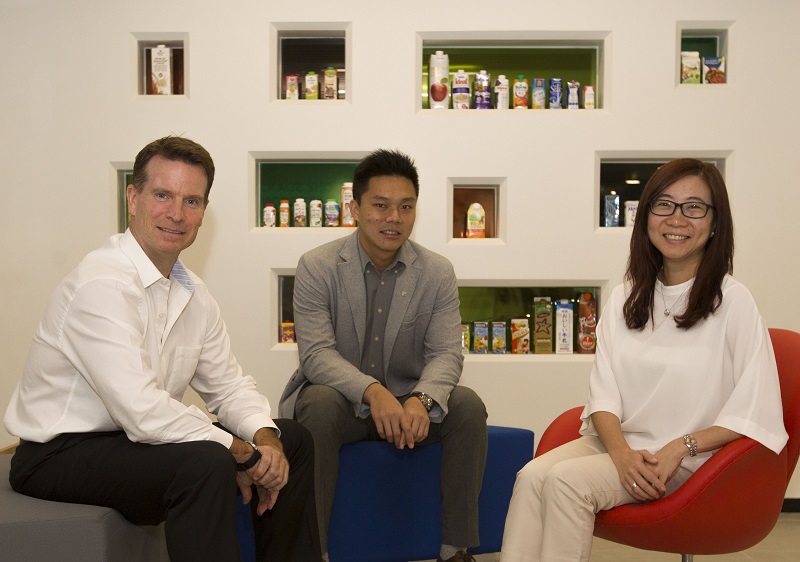
(From left) Tetra Pak’s environment manager, Terrynz Tan; managing director of Tetra Pak Malaysia, Brian May; and Forest Stewardship Council (FSC) country manager, Leslie Jong.
As consumers, it is not uncommon to check the ingredients of a product before purchasing it but how often do we check how the packaging was produced? According to the managing director of Tetra Pak Malaysia, Singapore and Philippines (Tetra Pak), Brian May, and Forest Stewardship Council (FSC) country manager Leslie Jong, this is important too.
One way to find out is to look for the FSC certification — a logo that incorporates a tree and a tick. It bears the promise that the product is made of paper obtained from responsible sources, such as well-managed forests, independently certified in adherence to the standards set by FSC — a global non-profit organisation officially founded in 1994 with a mission to stop global deforestation.
“Currently, over 190 million hectares of forest across 80 countries are FSC-certified. Out of that, 750,000ha are in Malaysia, where there are 13 forest management units — 11 in Sabah and two in Terengganu,” Jong explains.
Acknowledging the abundant advantages of sustainable forestry, FSC has worn multiple hats, including that of watchdog and advocate, in ensuring forests are managed well. Its main role is to ensure that they are managed in a way that preserves the natural ecosystem and benefits the lives of local people and workers, all the while ensuring that they remain economically viable. This includes paying special attention to areas of high conservation value such as those that contain significant concentration of plant or animal species. Hence, opting for an FSC-certified product would in the long-run contribute to sustainable forest management.
“The FSC logo tells consumers that they can rest assured the packaging involves a process that is safe and comes from a sustainable source,” Jong adds. Tetra Pak’s environment manager Terrynz Tan says this is something consumers are becoming increasingly aware of. She tells us this is especially so with the younger generation and that research has shown that “millennials are the first generation to put sustainability over cost”.
“Customers are demanding more and more environmental initiatives (and at the same time), it is important to Tetra Pak as well. Seventy-five per cent of our packaging is paper and if we want to have a sustainable business going forward, it makes good business sense for us to ensure the key raw material (for our packaging) is managed in a responsible, sustainable way,” says May.

This year, the two entities celebrate the 10th anniversary of their partnership. Tetra Pak — which is in a growing list of suppliers of FSC-certified products — is proud to announce that 100% of all its paperboards now come from sustainable sources, be it FSC-certified forests in Brazil and Europe or other controlled sources. “The core of what we believe in as a company — not just in Malaysia but globally — is that if we want to continue to be successful, we have to ensure that we keep a close eye on everything we do and how it impacts the environment,” he adds.
Although the FSC planted its roots in Malaysia in 2014, its partnership with Tetra Pak began before that. Over the years, both parties have worked hand in hand to promote sustainable sources of paper used to produce Tetra Pak’s packaging material. To date, Tetra Pak has delivered 280 billion of such packages globally; it sent out 65 billion last year alone. Locally, the visibility of the FSC label on Tetra Pak packaging has grown from 40% when the sustainable packaging was first made available in 2014 to over 70% today. May tells us that the figure is expected to increase.
Packaging made from sustainable sources look no different from its counterparts but there’s more to the true value of the collaboration than meets the eye. It has far-reaching benefits in preserving the entire ecosystem that branches from the forest, including the indigenous communities that have long called it home.
Dubbed “packs that grow back”, the multitude of paperback-based packaging that Tetra Pak produces for its clients puts sustainability at their core. While recycling is a key aspect in ensuring that used packaging is discarded responsibly, the food processing and packaging company goes a step further in terms of environmental conservation by ensuring the paper used to make its packaging come from responsibly-managed forests. To date, Tetra Pak has more than 486 collection points across the country, some of which benefit charitable organisations like Pertubuhan Amal Seri Sinar and Taiwan Buddhist Tzu Chi Foundation Malaysia.
[Packing made from sustainable sources] has far-reaching benefits in preserving the entire ecosystem that branches from the forest, including the indigenous communities that have long called it home
“The environment has always been a very deeply-rooted concept within the company. Before we launched the first FSC-labelled product in 2007, the company had always been stringent and had very tight policies on sourcing. We wanted to take that one step further by working with a recognised body to give us credibility and assurance to consumers, in addition to having it as part of our corporate governance. We found that FSC was an organisation that could provide us with that link to communicate with consumers directly. Two organisations that share the passion of taking care of the forest came together to provide a better choice for customers,” Tan elaborates on the collaboration, which encompasses the brand’s three sustainability pillars — food, people and futures.
Tetra Pak tries to ensure it does not negatively impact the environment and the communities it operates in, adopting a number of initiatives such as supplying nutritious drinks to school children. Globally, this programme is carried out in 57 countries. Tetra Pak has supported the School Milk Programme in Malaysia since its inception in 1983. In line with that is a recycling programme called Nurture for Nature, under which Tetra Pak helps schools set up a process on site to efficiently collect the milk cartons for recycling.
Another initiative is the CAREton Project, which demonstrates a clever use of recycled drink packs. In partnership with KPT Recycle Sdn Bhd and EPIC Homes, it built 20 homes for underprivileged Orang Asli communities in Batang Kali in 2014 and 25 homes for flood victims in the east coast the following year. Collectively, these initiatives sum up the brand’s promise, Protects What’s Good, through conscious decisions that make a difference in the economies that it benefits from, one responsible pack at a time.
For details on how you can participate in Tetra Pak’s local community initiatives, visit www.tetrapak.com.my.


